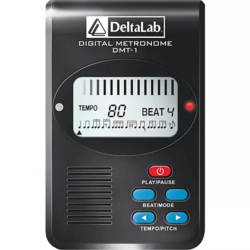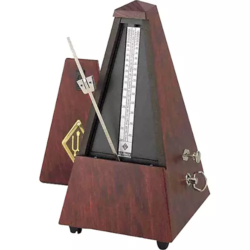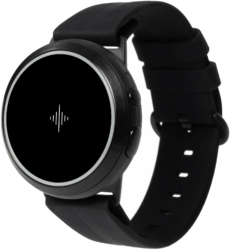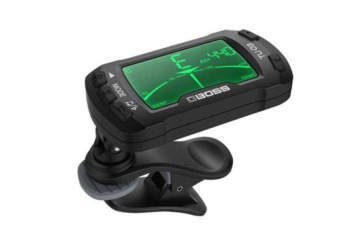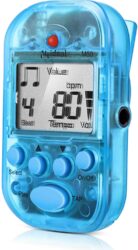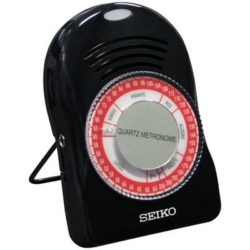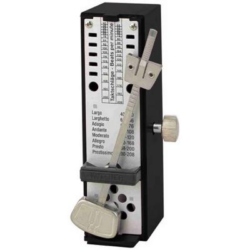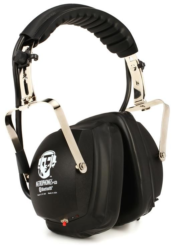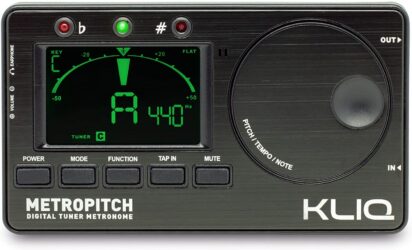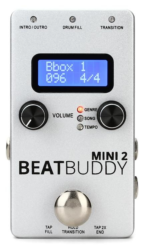A metronome is an invaluable tool for the practicing musician. As they learn and create pieces, they can develop the consistent pace they need and, as they perform with others, they can come together in one mind.
- Finding the Perfect Metronome for You
- Top 10 Best Metronomes 2025
- 1. Overall Best Metronome: Deltalab DMT-1 Digital Metronome
- 2. Best Premium Metronome: Wittner 811M Metronome
- 3. Best Wearable Metronome: Soundbrenner Core Steel Musician's Smartwatch
- 4. Best Clip-On Metronome: Roland TU-03 Clip-On Tuner and Metronome
- 5. Best Budget Metronome: MeIdeal Mini Digital Metronome
- 6. Best Quartz Metronome: Seiko SQ50V
- 7. Best Analog Metronome: Wittner Taktell Ultra Mini Series 880
- 8. Best Recording Metronome: Metrophones Digital LCD Headphones
- 9. Best Pocket Metronome: KLIQ MetroPitch
- 10. Best Pedal Metronome: Singular Sound BeatBuddy MINI 2
- Everything You Need to Know About Buying a Metronome in 2025
- Final Phrases
Finding the Perfect Metronome for You
In order to find the perfect metronome for you, it is important to take into account what you want to use it for, what sounds are more pleasing to your personal tastes, and what functions it can provide.
What Does the Metronome Sound Like
For some people, any sound is comfortable, as long as it is loud enough. A metronome with good volume control is more important than anything else. For others, something is comforting about the click of an analog metronome, and it can sometimes even be a sound replicated by digital options.
Perhaps, as is the case with performing musicians, you do not want any sound. Having metronomes that provide clear visual cues can be useful. Modern solutions, like the Soundbrenner Core Steel even offers metronomes that vibrate against your skin.
What Rhythms Does the Metronome Offer
The tempo a metronome offers is important if you are playing music that is considered very fast or slow. However, for most musicians, any metronome will have a range that suits them. What may become more important is if you often play songs with unusual measures. When practicing in 5/8 time, for example, it is helpful to differentiate the end of a measure by using a bell, or a different sound.
How Does the Metronome Create the Tempo
It is vitally important that a metronome produces an accurate and consistent rhythm. A metronome that says it is running at 60 bpm but really runs at 60.1 bpm may cause noticeable problems when a piece runs for three hours. Because of this, it is important to examine the accuracy of the metronome you are using.
Contrary to what some believe, high-quality analog metronomes are as accurate as digitals, and sometimes more so when compared to cheaper devices. A quality quartz metronome, like the Seiko, is often the most accurate available.
What Is the Size and Shape of the Metronome
Carrying a large, pyramidal metronome as you tour in a rock band may not be a useful decision, while a smaller metronome may be more difficult to see if placed on a music stand or at your feet. Think about where you will be putting your metronome when you use it, and what metronomes will best suit that setting.
What Extra Features Are Included
Many modern metronomes include a large number of extra features. While many also work as tuners for instruments, this can involve everything from a tone generator to feedback from a microphone. Some metronomes also offer a “tap tempo”, in which you tap on a button and the device finds a similar tempo to offer you.
With this in mind, we’re going to take you through the best metronomes.
Top 10 Best Metronomes 2025
1. Overall Best Metronome: Deltalab DMT-1 Digital Metronome
Why we like it:
With a large tempo range and a low price, this digital metronome will suit most musicians quite perfectly.
Quick Specs:
- Dimensions:3.7" x 2.7" x .6". 3.5 oz
- Tempo Range:30-360 bpm
- Mechanism:Digital, powered by 2xAAA batteries
- Extra Features:Tone generator, Headphone jack
Deltalab only sells two types of products, metronomes, and tuners. This focus means they have taken the time to think about what is most important to musicians and how they can best cater to these needs.
The DMT-1 emphasizes being a metronome, rather than a tuner that happens to include a metronome. This means offering a wider tempo range than any other device on the market. It offers up to nine beats-per-measure, which means the signature you’ll want is available every time.
The large display screen and bright LED means following a silent metronome is easy, while the volume on the built-in-speaker can be turned up loud enough to be useful to drummers. If you’d rather your metronome to be used through your headphones, the included jack allows for this. While it doesn’t contain a tuner that offers feedback, it does have a tone generator that sounds clear enough to use to tune off.
The DMT-1 is light and small and lasts a long time on only AAA batteries. This makes it a great portable device that can be kept in the pocket of your violin case or sitting on your music stand. In its design is included a folding stand to make it easier to see when placed on any flat surface.
The only function the DMT-1 is missing is the memory to hold multiple presets. Fortunately, setting up a new beat is extremely simple and doesn’t take much time. If missing this function is why we can have such a good device at so low a cost, we are happy to do without.
The Deltalab DMT-1 is an impressive device that makes sure to offer a musician with everything they would need from a metronome.
Pros
- Wide range of tempos and measures
- Great for visual and audio cues
- Easy to use
- Small and light, with great longevity from battery power
- Great price
Cons
- Does not include memory for multiple preset beats
Why we like it:
A high-quality analog piece that reminds us that sometimes perfection was achieved a long time ago.
Quick Specs:
- Dimensions:4.13”x 4.13” x 8.66”. 17.7oz
- Tempo Range:40 - 208 bpm
- Mechanism:Analog, winding
- Extra Functions:none
Gustav Wittner started making metronomes in 1895 and today his great-grandchildren continue the tradition. The precise German engineering of these devices proves that mechanical metronomes are as accurate as any digital device.
The Wittner 811M is a new model of the original design, made with clockwork precision and encased in mahogany. Just as over a century ago, it is powered by a brass winding key. The analog metronome offers a wide range of tempo and a clear bell that provides a measure of 2/4, 3/4, 4/4, or 6/8.
The beautiful desk-metronome sits on four rubber feet to not mark the surface underneath and can sit on a piano without worrying about damage. Its sound is clear and consistent and can be heard over most instruments, though would not be suitable for drummers.
The Wittner is not about offering a wide range of auxiliary functions but providing the most important function to the highest degree of accuracy, in a way that has been passed down for centuries.
Beautiful, accurate, and reminding the musicians of today about a long-lasting heritage of rhythm, the Wittner 811M is a gift for professional musicians that will be used and loved.
Pros
- Highly accurate mechanical functions
- Clear sounding bell offers multiple measures
- Powerless running
- Quality mahogany outer
- A part of musical history
Cons
- No extra functions
3. Best Wearable Metronome: Soundbrenner Core Steel Musician's Smartwatch
Why we like it:
A great example of what modern technology can do, this metronome is a rock star’s dream.
Quick Specs:
- Dimensions:Size of a watch
- Tempo Range:20-400 bpm
- Mechanism:Digital sounds, vibrations, and light. Powered by a rechargeable battery
- Extra Functions:Fully functioning smartwatch, connects to devices via BlueTooth, and more
For the tech-head, there is little not to like about the Soundbrenner. A smart-watch designed for musicians, it includes a metronome and tuner, as well as a warning system for decibel levels, and the typical benefits of the modern smartwatch.
The metronome part of the watch is incredible. Choose between the visual display, audible beeps, or, most impressively, vibrations. These vibrations can be controlled to make them as strong or weak as you like, and all through a twist of the watch face. With a wide tempo range and the ability to set different forms of vibration to indicate different measures, this is a great metronome for the musician who doesn’t want to be seen using a metronome.
The feedback this watch provides is unparalleled. The tuner is highly sensitive to sounds, but can also be used by magnetically sticking to an instrument and responding to the vibrations. The watch warns you if you are experiencing sound levels that may harm your hearing, and settings can be changed via your smartphone.
As a smartwatch, it is pretty good as well. While a bit thicker than other smartwatches, it is water-resistant, has a stainless steel casing, and offers a massive five-day battery life when on standby. As a vibrating metronome, it can handle three hours of constant activity, as good as you would ever need in a gig.
Of course, this sort of metronome is not going to suit everyone. It is a little heavier than your typical watch and the vibration function might impede the professional player who needs a sensitive touch. This smartwatch also has the price tag of a smartwatch so those of us just looking for a metronome may decide it isn’t worth it.
For the band member who wants an unobtrusive, high-tech and ultimately impressive device, the Soundbrenner is a metronome unlike any other. As modern as technology can be, and highly recommended for today’s musicians.
Pros
- Fully functioning smartwatch with metronome and tuner included
- Connects to a smartphone for all functions
- Offers sound, visuals, and vibration modes
- Magnetic base for tuning using vibrations
- Decibel meter for hearing health
Cons
- Vibration mode may be a hindrance
- Larger than most smartwatches
- Expensive
4. Best Clip-On Metronome: Roland TU-03 Clip-On Tuner and Metronome
Why we like it:
Small, easy to read and a padded clip make this a great metronome to have on your instrument or stand.
Quick Specs:
- Dimensions:1.75” x 2.63” x 1.5," 2.1oz
- Tempo Range:30-250 bpm
- Mechanism:Digital; powered by CR2032 battery (included)
- Extra Functions:N/A
Designed to clip to the head of most stringed instruments, the Roland tuner and metronome offers a large, back-lit display and volume-controlled speaker to provide a clear beat. Most importantly, the sound can be turned completely off, with the visual aid being easy to see even out of the corner of your eye. Impressively, the screen is easy to read in even the brightest of environments.
There are eight patterns and ten beat variations on offer with this metronome which means it suits the vast majority of styles and time signatures you will come across, and the tempo can be changed at the touch of a button.
The large, spring-loaded clip can comfortably fit onto both thick and thin pieces, which means it holds just as well to a thin music stand as it does to the head of a Gibson. It is also padded, so no fears of leaving any marks or indents behind on the more fragile instruments.
The Roland is as much tuner as a metronome, and it allows you to tune to any pitch, making it suitable for all stringed instruments. It even has preset modes for violin, guitar, bass, and ukulele.
Of course, the clip-on metronome is obvious to see, so for the performer who might be embarrassed about using a metronome, it may not suit. While it has a battery included, these can be a little expensive to replace; fortunately replacing batteries is something you will rarely need to do.
The Roland is a great metronome and tuner in one, that has the best screen we have found on a digital metronome. For practice with any instrument, it’s a good choice.
Pros
- The clear screen, even in bright environs
- Eight patterns and ten beat variations
- Complete metronome and tuner in one small package
- A large, padded clip that doesn’t leave damaged surfaces
Cons
- Very obvious to see in a performance environment
- Batteries will need replacing if used often
5. Best Budget Metronome: MeIdeal Mini Digital Metronome
Why we like it:
With a surprising number of functions and quality-of-life additions, this miniature metronome really shouldn’t cost you the price of a cheap lunch but it does.
Quick Specs:
- Dimensions:3” x 4.5” x 3.3” 1.2oz
- Tempo Range:30-280 bpm
- Mechanism:digital, sound, and light; powered by CR2032 cell (included)
- Extra Functions:Headphone output
The MeIdeal is small, lightweight, and easy to use, and is therefore perfect for the school student looking for their first metronome. Offering the same tempo range as other metronomes as well as ten beat variations, all the primary functions you would want from a metronome are there.
The MeIdeal also offers a flashing light as an alternative way of keeping the beat if the high-pitched beep does not suit you, as is the case with some of its users. As well as the nice little touch of being able to choose your own color, the MeIdeal offers a clip and can be attached to a lanyard quite easily. It also offers a headphone jack so you can listen to the beep without disturbing others. This function isn’t always available in other metronomes so is appreciated.
Of course, some things are required to be missing for a device to be offered with as low a price as this. In the case of MeIdeal, compromises are made in volume control, with only three settings, and battery life which isn’t that long. Fortunately, batteries are easy to change and inexpensive to purchase.
For your first metronome or a nice present to give to music students, you can’t go wrong with the MeIdeal Mini Digital Metronome.
Pros
- Able to set own beat using “tap” function
- Choose from a range of colors
- Headphone jack
- Clip and optional lanyard
- Very inexpensive
Cons
- Only three volume settings
- High-pitch beep annoying to some
- The battery has a short lifespan
6. Best Quartz Metronome: Seiko SQ50V
Why we like it:
From the well-known watch brand comes a highly accurate metronome that takes up very little space
Quick Specs:
- Dimensions:1.7” x 5.1” x 3”. 5.6oz
- Tempo Range:40-208 bpm
- Mechanism:Digital and Quartz; powered by 9V battery (included)
- Extra Functions:Two-tone tuner and kick-stand
Seiko has been creating timepieces since 1937, and so they know the importance of accurate timekeeping. Using these same practices, they have produced a metronome you can trust will keep an accurate beat at any tempo.
It is definitely the metronome that is the simplest to use. Switch it on, set the dial to the tempo you want, and turn up the volume. That is it. When you switch it on, you can pick two different sounds, which also happen to be for A and B-flat tuning, and the flashing light serves as a great visual metronome if you keep the volume down. The ability to offer these other features without complicating its job as a metronome is a tribute to simple, effective engineering.
The Seiko doesn’t offer a range of beat variations, nor does it’s tuning abilities move beyond those two tones. What Seiko offers is a name you can trust for highly-accurate beat-keeping and, for that alone, it definitely makes our list.
Pros
- Highly accurate quartz mechanism
- Two different sounds, which can also be used for tuning
- Very simple to use
Cons
- No beat variation
- No other functionality
7. Best Analog Metronome: Wittner Taktell Ultra Mini Series 880
Why we like it:
Wittner’s high-quality metronome also comes in a portable, stripped-down version at a much more reasonable price.
Quick Specs:
- Dimensions:1.5” x 2.1” x 4.6". 15.6oz
- Tempo Range: 40-208
- Mechanism:analog, winding
- Extra Functions:None
You may recognize Wittner as the brand of our Best Premium Metronome, and it is no surprise that the only other analog metronome on our list also comes from the company. It is a true credit to their engineers to find a way to create a balanced, high-quality analog device that is also safe and easy to store in your luggage when you travel. Eschewing the pyramidal structure of most analog metronomes, this box-shaped device is small enough to slip into your overnight bag while leaving room for more important things.
Because it uses a hard-plastic casing and a minimalist design, Wittner has also been able to offer the 880 at a price much cheaper than other analog options. For those of us who desire that clean “click” instead of a digital “beep,” it’s nice to know we don’t have to pay extra for it.
As you would expect from such a metronome, it comes with no whistles, just the bell, and it certainly isn’t as beautiful as its sibling. If you are interested in a case, they do exist, but do not come included. When you want an analog metronome and can’t afford the best, you certainly won’t regret buying the Wittner 880.
Pros
- Same functionality as our premium choice
- The smaller size and shape for travel
- Very competitive price, even against digital metronomes
Cons
- Does not come with a protective case
- No extra features
8. Best Recording Metronome: Metrophones Digital LCD Headphones
Why we like it:
We love this metronome because of its innovative design. It's one of the few metronomes that's combined with headphones.
Quick Specs:
- Dimensions:Over-the-ear headphones
- Tempo Range:40-250 bpm
- Mechanism:Digital, powered by a rechargeable battery
- Extra Functions:stereo line or BlueTooth, noise-canceling, LCD
For the studio recording, having an audio cue is not an option. If you are someone who doesn’t find visual metronomes all that useful, it can be difficult to find a compromise that works. Fortunately, Metrophones have come up with an elegant solution: put a high-quality digital metronome directly into a pair of comfortable, noise-canceling headphones.
Providing 29dB passive isolation and with very comfortable gel-filled cushions, these headphones are tempting even when you don’t want the metronome. They work both wired and wirelessly using Bluetooth and the rechargeable battery lasts for forty hours of use.
The metronome itself is built into the headset, the beat displayed on a small LCD screen inside one of the ears. The controls are built into the headset, changing the tempo with a simple toggle. The volume of the metronome can be changed to suit you and the music that is coming through the phones, while the sound is a crisp “tick” rather than the annoying “beep” that some other digital metronomes provide.
It’s not all good news. The metronome doesn’t offer beat variation, and the price is on the upper end of the scale. However, for a band in a studio, these things are not as important as finding that solution to the question: “How can I hear a metronome and not ruin my song?”
From one of the best headphone companies for musicians comes a metronome solution that will change your recording practices forever.
Pros
- High-quality headphones with noise-canceling and BlueTooth
- Crisp, clear “tick”, with volume changing ability
- Easy-to-use controls and LCD screen
Cons
- No beat variation
- Very expensive
9. Best Pocket Metronome: KLIQ MetroPitch
Why we like it:
A small, stylish metronome/tuner that has everything you could want for a reasonable price.
Quick Specs:
- Dimensions:4.3" x 2.4" x 0.6". 0.3oz
- Tempo Range:30-250 bpm
- Mechanism:Digital; powered by 2 x AAA batteries (included)
- Extra Functions:Tuner, tone generator, recording ability
While the MeIdeal is the cheapest metronome we found that is still a good metronome, if you are willing to pay a little extra you can buy something that offers a whole lot more. The KLIQ MetroPitch is not just a metronome but also a tuner and tone generator. As a metronome it offers 10 beats per measure, and 5 time division variations, making it one of the more versatile choices out there. With input and output jacks for guitars and a memory backup to store choices, there is little in terms of functionality that we can say is missing.
The MetroPitch comes in a metallic case with a stand and is stored in a fabric pouch. It’s so small, however, that you could just as easily just keep it in your pocket when not using it.
The KLIQ does have some drawbacks, however. The volume of the metronome doesn’t get loud enough to suit a lot of musicians, easily drowned out by even a quiet electric guitar. This is partly due to the low power given to the speaker, but also because of its positioning on the back of the device. The batteries also do not last long on the KLIQ, and will need replacing often. Fortunately, it takes standard AAA batteries.
For a low-cost, high-function metronome that is also small and stylish, the KLIQ is a solid choice.
Pros
- All-in-one tuner/tone-generator/metronome
- Small and stylish
- Input and output jacks
- Remembers preset beats
Cons
- Low volume on the metronome
- Short battery life
10. Best Pedal Metronome: Singular Sound BeatBuddy MINI 2
Why we like it:
The sort of device that could replace a drummer, or at least provide an alternative in a pinch, this is more than a metronome.
Quick Specs:
- Dimensions:4.7” x 2.7” x 2.5”
- Tempo Range:Variable
- Mechanism:Digital: powered by 9v DC
- Extra Features:None
The BeatBuddy Mini 2 is more than a metronome. It is a drum machine. It works as a metronome but offers far more. Storing over 200 rhythms in the sound style of 9 different drums, you can change each one to suit the tempo you are looking for at the turn of a switch. Using the right software, you can even design your own beats to use. Designed for the feet, the button is comfortable even in socks but can also handle the overzealous player.
The BeatBuddy is a powered device and, strangely enough, not one of the pre-stored “songs” is a beat without an intro. However, all tempos and rhythms you might be looking for are stored there, you just need to go looking. You can even look at their handy database, which includes matching well-known songs to the beats that suit them.
While it might not be the thing the music student or orchestral player is looking for in a metronome, the garage muso will be blown away by how much more the BeatBuddy Mini 2 can offer them.
Pros
- Offering a full drum-kit experience including lead-ins, etc
- Over 200 “songs” using 9 different drum sounds
- Full range of tempos
- Great foot pedal-designed button
Cons
- More complex than a simple metronome
- Doesn’t offer a single beat preloaded
- Corded power
Everything You Need to Know About Buying a Metronome in 2025
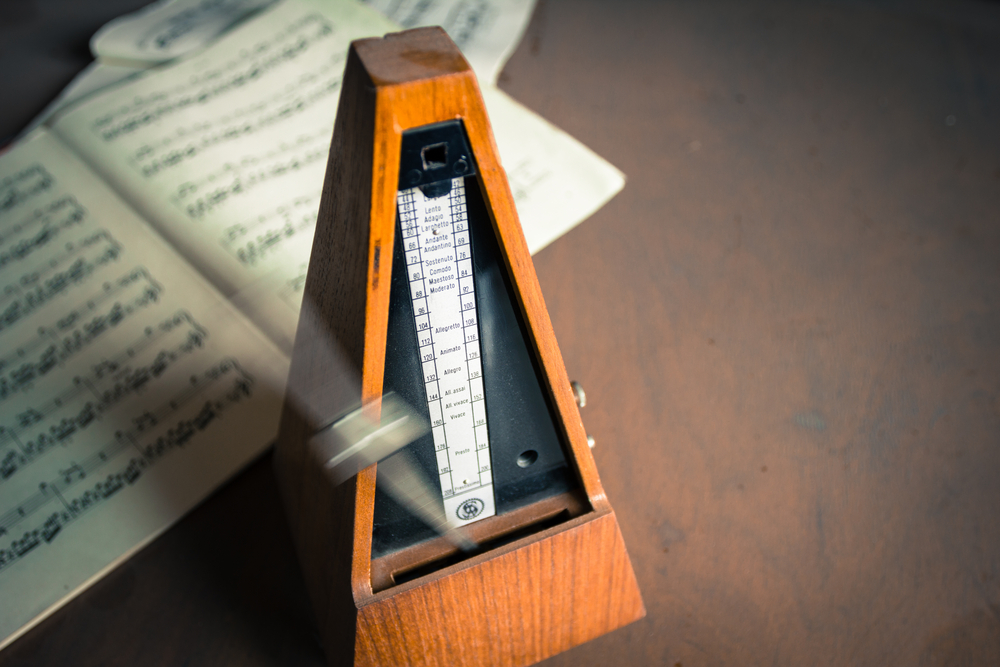
Metronomes Are All About Setting Pace
The purpose of a metronome is to set a consistent pace with which to practice and play music. To gain this consistency, we need a metronome to be highly accurate and have a range of tempo that matches the music we play. A rock star may be satisfied with a range between 40 and 100 beats per minute, as most rock music falls in this range. However, an EDM producer often creates tracks well over 150 beats per minute, while a symphony orchestra may play pieces as low as 20.
We Need to Like the Sound of a Metronome
Well, not so much “like” as “not be distracted by.” A metronome should set the pace without being obtrusive to our thoughts. This is quite subjective, but we may find the ticking of an analog metronome to be far more calming than the beep of a digital one. More importantly, we need to not have to strain to hear a metronome over our own sounds, but not make it the sound that drowns out all others. So, the type of sound, and the volume of said sound, play important roles in what metronome we choose.
Metronomes for Performance
If we are planning on using a metronome during a performance, we will not want it to be heard by the audience. Whether this means a purely visual metronome or one that is “hidden” using vibrations or headphones is up to us.
Practicing With Metronomes
Practicing with a metronome allows you to develop timing when you read and play sheet music. Rather than play easy parts of music at a different pace to more difficult sections, playing to a metronome will help you set a consistent pace.
To use a metronome in practice, you can set a low tempo, regardless of the piece, to learn the correct notes and pacing. Then, as you become more confident, you can raise the tempo to the desired setting, matching it to the intended pace of the composer.
Using a metronome can also help groups of musicians find a consistent pace for when they come together. If one violinist naturally plays at 65 bpm and the other at 60 bpm, without a metronome they may first struggle to work together in a quartet. However, if both have been practicing at 65, both will come together smoothly.
Setting a Metronome
When you are first practicing the piece, the setting is not strictly important. Find a pace that is slow enough for you to feel comfortable learning the music. When you feel like you are ready, you can then set the tempo to a setting that matches the description of the piece, or that matches the tempo of the other players.
Why Metronomes and Tuners Work Well Together
Many metronomes double as tuners, which is very helpful considering how many of us need to tune our instruments. We may not always have access to a keyboard or piano before using our stringed instruments, but tuning a guitar or violin is the first step in every use.
Having one device that can cover both these functions in these cases can be useful, especially if you are a traveling musician.
What 3/4 and 4/4 Mean When Using a Metronome
These fractions refer to “beats per measure”. A waltz is generally in 3/4, while most rock and pop in 4/4. When using a metronome, most players count one “click” as a quarter note. This means three clicks or beats make a full measure during a waltz.
Some metronomes offer settings that can ensure the measure is indicated by a sound different from the others. This may be a bell on a traditional analog metronome or a different sounding beep on a digital one. In the case of our favorite metronome, the DeltaLab, it can offer measures as unique as 5/8 with ease.
A measure is presented in sheet music by using “bars.” As you learn to read music, you will come to use these bars to ensure the notes you play to match the measure you have created with the metronome. You will know if the note you play is at the correct moment by if it appears before, after, or on the click. As you develop these skills, you perfect the pace of your playing.
“Adante” and Other Archaic Words
“Adante”, “Allegro”, and “Largo” are just some of the words the composers may use to describe the pace of their music. While in the past musicians would play their “best guess” at the pace the composer intended, the players of today tend to choose a tempo within certain ranges.
Today, “Adagio” is played at 55-60 bpm, while “Adante” is played at 73-77. Music can range from “Grave” (20-40) all the way to “Prestissimo” (178+). Modern EDM would be considered “Prestissimo” while Bach’s famous “Air on G String” is played Adagio.
Final Phrases
Most metronomes will fit the basic needs of any player, offering tempos to match 99% of songs you will play, and having sounds that are easy to hear. However, the best metronomes offer more. Whether that is a range of measures, clear visual clues, or intelligent designs that allow unobtrusive use, the best metronomes take that extra step. The metronomes we are most excited about and are listed here, all make that leap. We are certain the one that fits you is among them.

